Aqua Culture or Fish Farming has become the new buzz word in the international Big Bucks arena. Although the practice of farming with fish is eons old, dating back to ancient Egypt and China, the ballgame has changed completely in the last decades from small-scale, home-grown fish for the table to a multi-billion dollar industry. 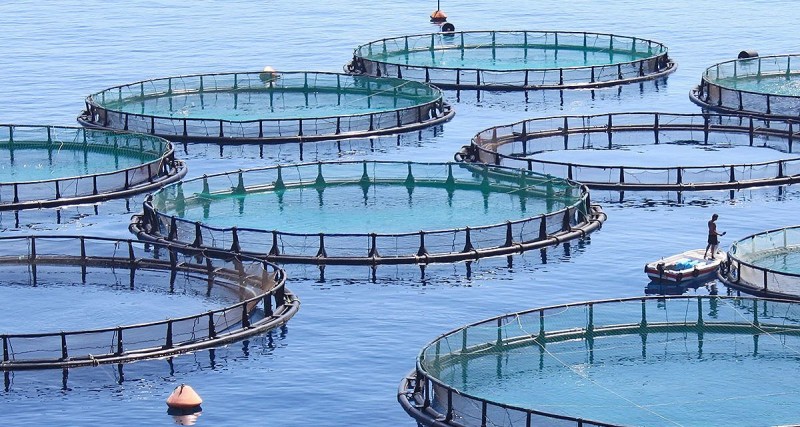
Suddenly every country in the world - from Alaska and America to Norway and Nigeria - is concerned about the world's health and dwindling food supply. Farmed fish is the new "craze and solution" and is lauded by players in the industry as the only future source of protein for mankind - apparently because the world's oceans have already been stripped by commercial fishing and pirating longliners (that, funnily enough, nobody is able to catch or stop?)
The competitive mega-bucks industry is spreading and flourishing like wildfire as new technology for improved sea cages flood the market and companies compete to produce the best/cheapest and most balanced/nutritious artificial fish pellets and food for the various farmed fish species. 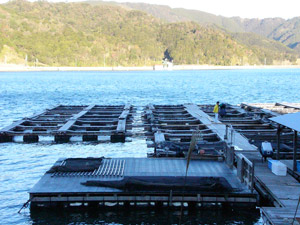
South Africa is a relative new-comer to the industry and has only in the last two decades decided to jump on the bandwagon with a few pilot projects, but it is still very experimental and small-scaled compared to the lucrative industries in some Eastern countries, Europe and America.
Since the Mossel Bay area has recently been earmarked for a pilot offshore finfish project to farm yellowtail in open cages, it might be a good idea to see what is truly going on in the industry; and why consumers are seriously cautioned to only buy/eat farmed fish and seafood products from certain accredited outlets to ensure it is safe and responsibly grown.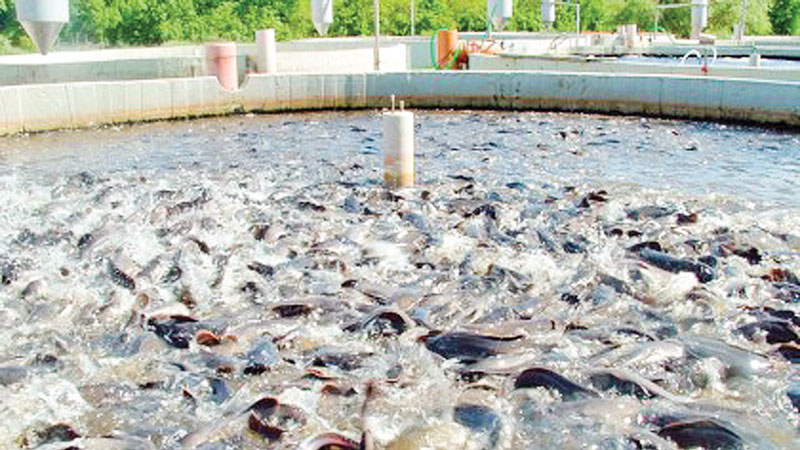
Photo: Fish farming in Bangladesh
It seems the industry is still in a very experimental phase regarding the long-term effects of all the pesticides, hormones, antibiotics and other chemicals used in the various artificial fish foods - not only to the ocean and marine life, but also to human health. Furthermore, every country still seems to be experimenting with, and researching new technology and sea cage structures to combat existing problems and to prevent farmed fish from escaping into the ocean and contaminating wild species with viruses, sea lice, etc.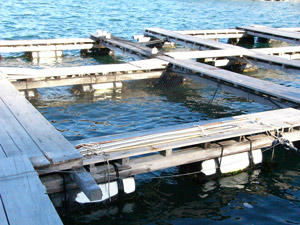
Photo: Fish Farm cages in Japan.
Especially finfish such as yellowtail is still a rarity in the industry. Many countries such as Alaska have prohibited finfish farming as it poses significant problems and risks compared to shellfish like abalone, oysters and mussels. Finfish such as carp, catfish, salmon, tilapia and yellowtail have to be fed regularly and with the "exact right" food; have to move constantly in confined cages and easily die from stress due to confinement.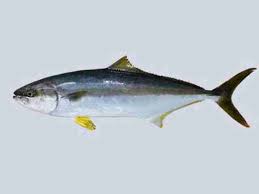
Photo: South African Yellowtail - where has it successfully been raised in fish farms?
The exact cause of severely deformed species of farmed fish in Australia and other places are still debated and attributed to either the "wrong" pellet-food, accelerated growth or stress, or a combination of all three. 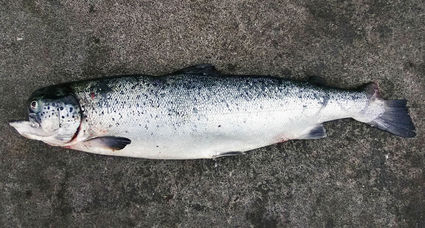
Deaf, deformed and depressed - an example of a deformed salmon raised on a fish farm
Farmed salmon suffer from deafness because their ears become deformed during their accelerated growth on fishfarms, research has found. Around half of all farmed salmon are at least partially deaf, caused by growths in their inner ears. http://www.dailymail.co.uk/sciencetech/article-4800074/More-95-cent-adult-farmed-fish-deformed.html
https://thenarwhal.ca/disturbing-new-footage-shows-diseased-deformed-salmon-b-c-fish-farms/
Researchers say the findings raise questions about the welfare of farmed fish.
Sea lice, parasites, viruses and other diseases need to be carefully controlled or prevented with pesticides and other chemicals and thus far, it has been impossible to prevent farmed fish from eventually escaping into the sea due to various factors - erosion and the deterioration of the nets and cages, stormy sea conditions and the impact of whales, orcas and sharks.
The impact of the nets on curious marine animals such as whales, dolphins, sharks and penguins in Mossel Bay's prolific waters is another great concern.
One cannot help wondering whether the noble practice of fishing for food for one's family has somewhere along the line been hijacked by corporate companies and distorted into a feeding frenzy in which food and the nutrition of humans come secondary to money-hunger greed . . . maybe at the cost of our oceans' and our own health . . .
Photo: Fish Farming in Nigeria
Here are some interesting facts and food for thought:
Is Farmed Fish a Healthy Choice?
Aquaculture is the practice of raising fish or ocean plants for food or resources. Today, many species of fish are raised in contained fresh water or ocean water environments, including salmon, catfish, tilapia, cod and others.
In fact, around 50% of the seafood we consumes comes from aquaculture. It is a $78 billion industry which has grown 9% a year since 1975. (6)
While aquaculture is nothing new as humans have been farming fish for millennia, there have been some substantial changes in recent decades. There is evidence of fish farming dating back to 2000 BCE in China and depictions of ornamental fish ponds in ancient Egytian paintings.
Modern fish farming practices often raise fish near the top of the food chain (affecting populations of fish that eat or are eaten by these species) and contain thousands of fish in tiny pens (similar to commercial chicken or cow operations). As you may imagine, these conditions leave something to be desired and affect both the quality of the fish and the health of the ocean.
Environmental Problems with Fish Farming
Fish farming is a way to create a much larger amount of fish much more quickly, cheaply and efficiently than with wild caught fish. Unfortunately, when something seems too good to be true, it very often is!
Pollution
This density of fish creates problems like disease and pollution. The biggest source of pollution is the accumulation of fish waste and uneaten food beneath the sea pens which can degrade the quality of the surrounding water.
Like commercial farming operations on land, the density of fish in these pens necessitates certain chemicals to keep animals from getting sick and to keep things clean. The chemicals used in marine aquaculture operations such as medicines like antibiotics and vaccines, disinfectants, and substances used to prevent corrosion of equipment (cages, etc.) can also change the composition of the surrounding aquatic ecosystem.
The amount of pollution from fish farms also depends on how the fish are contained. Open-net, or pen systems, allow for a direct exchange of water, where as “closed contentment” methods have a barrier which filters the water.
Impact of Biodiversity
Another way aquaculture can have a negative impact is by introducing farmed species into the wild and therefore changing the biodiversity of aquatic ecosystems. Even when measures are taken to prevent escapes, predators like birds and sharks, equipment failure, human error, severe weather and other complications mean that escapes of farmed fish are inevitable.
Since farmed fish often have been bred via selective breeding they have a lower genetic variation than wild fish. If they interbreed with the wild fish it can result in a less genetically diverse, and therefore less robust, population.
Another concern is infertile offspring. For example, Atlantic and Pacific salmon belong to different genera and while they can produce offspring, those offspring will be unable to reproduce (like mules). If populations of non-native species become established they compete with native populations for resources such as food and breeding sites. (8)
Since farmed fish are selected and bred for certain genetic criteria like size, quick growth and hardiness, escaped species can become invasive, which has been recognized as one of the main causes of global biodiversity loss. One example of this was the Pacific oyster in the UK, which was introduced into its waters in the 1960s via aquaculture with the idea that it would be a more commercially viable species than the native oyster. Unfortunately, these pacific oysters have spread and created reef formations, forcing out the native oysters and altering the marine environment.
Tilapia Takeover
Another example of the negative effect of fish farming on native fish population and environment is with Tilapia. Tilapia is one of the most common types of farmed fish. Most of our tilapia supply is imported from Latin American and Asia, and in 2015, Americans ate 475 million pounds of tilapia.
Tilapia is a warm-water fish native to Africa, but in the last 60 years the governments of poor tropical countries saw the fish as a solution to control weeds and mosquitoes in lakes and rivers, breeding and releasing tilapia into these areas. They are now seen as a nuisance, as they are one of the “most invasive species known and difficult to get rid of once established,” says Aaron McNevin, a WWF biologist.
In Lake Apoyo in Nicaragua, tilapia escaped from a fish farm and their pollution and feeding reduced the lake’s quantity of an aquatic plant called charra, which was an important source of food for the lake’s native fish populations. Sixteen years later, the lake’s biota are still recovering. (3)
Spread of Disease & Antibiotic Use
Because farmed fish are raised on unnatural diets and in small enclosures they often breed disease, which can pass to wild populations. This is becoming an increasingly big problem, as are the solutions often used for these diseases.
Some aquaculture productions rely on prophylactic antibiotics to prevent infections. The use of antibiotics can cause drug resistant bacteria to develop which can spread to wild populations. (1, 2)
Sea Lice
Another common disease is sea lice. Not to be confused with an itchy, stinging rash caused by jellyfish larvae, these sea lice are planktonic marine parasites which feed on many types of fish. There are many species but the common “salmon louse” or lepeophtheirus salmonis, has become a big problem for both wild and farmed salmon populations. About a centimeter in size, the sea lice attach themselves to the outside of a fish and feed on its mucous, blood, and skin. (16)
This can cause serious damage to fins, erosion of skin, constant bleeding, and open wounds at risk of infection. On an adult fish this may be only a nuisance, but for small juvenile salmon (around the size of a finger), sea lice can be fatal. (15)
Before offshore industrial scale fisheries became big business in the 1970s, sea lice were rarely epidemic to fish populations. Of course, when hundreds, or even thousands of fish are crowded together in a small area, sea lice, and other diseases can easily spread from fish to fish. (14)
This problem not only impacts food supply and fish industry profits, it is spreading to wild fish populations. One example is the salmon in the Broughton Archipelago, a group of islands 260 miles northwest of Vancouver, British Columbia.
In 2007 the area had 20 active fish farms, which raised between 500,000 and 1.5 million fish each. As juvenile wild salmon swam past these open-net farms on their way down river towards the sea, the sea lice infecting the farmed salmon attached to them. A study done that year found that the number of wild pink salmon were down 80% since 1970 because of sea lice infestations. The study concluded that at this rate the wild salmon in the area would die off in four generations or by 2015. While the conclusions of this study were not without controversy, it did seem that the salmon populations recovered when the farms idled. (15)
Pesticide Use
As sea lice became a problem in fisheries around the world, an unfortunately common solution was employed: pesticides. One chemical commonly used was emamectin benzoate, or Slice, which when administered to rats and dogs causes tremors, spinal deterioration and muscle atrophy.
Of course soon the lice became resistant, and Slice only worked in triple doses. Other chemicals like hydrogen peroxide, Salmosan, AlphaMax and Calicide chemicals have been employed instead.
While we know that these chemicals can negatively affect ocean water and plant species, we don’t have enough research to know how much of these chemicals are absorbed and retained by the fish and if any of this passes to those who eat the fish. (14)
Fish Farming: Effects on Fish
As you might imagine, most species of fish don’t thrive when being raised in extremely cramped pens, fed commercial feed, and treated with pesticides, antibiotics and other chemicals. We now know that thees modern practices negatively affect the fish as well as their environment.
Higher Levels of Omega-6
Like all animals, fish are what they eat. The nutrition of our food depends on the nutrition of our food’s food. For example, salmon in the wild eat smaller fish, which eat aquatic plants rich in beneficial long chain omega-3 fatty acids DHA and EPA. Farm-raised salmon eat pellets, and as the nutritional quality of pellets varies, so does the nutritional quality of the fish. Often young salmon are fed pellets made from plant and animal sources, and they receive more expensive fish/fish oil enriched pellets later in their lifespan just before harvest. (7)
New commercial fish feeds are more likely to have protein and oils derived from grains and oilseeds (like soybeans and canola) and with less fishmeal and fish oil. The difference in feeds accounts for why one study that measured the omega-3 contentment of fish species from six regions of the US found large variations in the omega-3 content in the five salmon species tested. (7, 8)
In the two farm raised varieties tested the omega-3 ranged from 717 mg to 1,533 mg per 100 grams of fish (which is equal to a 3.5 oz serving). Compared to the wild-caught varieties, these farmed fish tended to have higher levels of omega-3s but only because the farmed salmon have more fat overall, including higher levels of omega-6 polyunsaturated fats and saturated fats. (7)
Feeds from vegetable sources can be more sustainable than fishmeal and fish oil. These are often made from smaller fish, lower on the food chain which are sometimes called reduction, pelagic, or trash fish. To create 1kg (2.2 lbs) of fishmeal it takes 4.5 kg (10 lbs) of smaller fish. In fact, today at least 37% of global seafood is ground up to make feed. In 1948 that number was only 7.7%. (4)
These lower food chain fish are the food for many species of aquatic life, and depleting them may cause serious implications for aquatic ecosystems and other sea animals including birds and mammals. (6)
PCBs and POPs
PCBs (polychlorinated biphenys) are industrial pollutants that find their way into fresh waters and oceans and then are absorbed by aquatic wildlife. PCBs are a type of POP (persistent organic pollutant). (10)
Type 2 diabetes and obesity have been linked to POPs, and certain types increase the risk of stroke in women. PCBs are potential human carcinogens, and known to promote cancer in animals. Other potential health effects include negative effects on the reproductive, nervous, and immune systems plus impaired memory and learning. (9, 10)
One study found that PCB levels in farmed salmon, especially those in Europe were five to ten times higher than PCBs in wild salmon. Follow-up studies haven’t confirmed this, and there are now strict rules on contaminant levels in feed ingredients which have lowered PCBs in these fish. (8, 9, 10)
It is best to avoid these chemicals completely, but most PCBs are found in the skin, so if farmed raised fish is the only option available, it is possible to reduce exposure by removing the skin and by avoiding fried fish. (10)
Things to Consider When Selecting Seafood
As if the various concerns associated with fish farming weren’t enough, there are other important factors to consider when sourcing any kind of seafood.
Mercury
Mercury toxicity can impact brain development in children and negatively affect cognitive function in adults. Mercury is found in the muscle of the fish. The biomagnification of mercury means that organisms higher on the food chain contain higher levels of the metal. (5, 10)
One way to consume seafood yet reduce mercury exposure is by eating smaller fish lower on the food chain, such as sardines. See the resources section at the bottom of this post for a list of fish ranked by their mercury levels.
The Selenium Myth
Many of us in the real-food community have heard that mercury is only a concern if there is not selenium present in the fish, and since most seafood also has high levels of selenium we shouldn’t be concerned about mercury.
Dr. Christopher Shade, recently confirmed in an interview with Chris Kresser that this is not the case. He verified that those who are deficient in selenium will be more susceptible to mercury toxicity; however, having good selenium levels doesn’t prevent someone from getting mercury toxicity from seafood. Nor does the selenium in seafood bind the mercury and therefore prevent us from absorbing the toxic metal. (5)
One important way the body rids itself of mercury is via glutathione, the body’s self produced master-antioxidant. It is therefore important to support this pathway by consuming sulfur containing vegetables like onions and brassicas, and good amounts of vitamin C.
Omega-3 Levels
Omega-3s are very important for health, and should be consumed in proper ratio with Omega-6 fatty acids. Statistically, most of us consume too much Omega-6 and not enough Omega-3, which some experts blame as one of the root causes of many modern diseases. Fish are an excellent natural source of Omega-3s, but there is a wide range of levels depending on the fish. When choosing seafood, it helps to know which fish have the highest levels of these beneficial fats. (For a list of fish ranked by levels of Omega-3s see the resources section at the end of this post.)
Sustainability
While farmed fish have obvious drawbacks there are also sustainability concerns about wild caught fish.
One of the major concerns is overfishing which has become a global problem. Obviously it becomes difficult to eat the fish if they don’t exist, but fewer populations of certain species can have repercussions for an entire ecosystem. (19)
Another issue is bycatch, which is when non-target animals are caught during fishing. This can include dolphins, sea turtles, birds, sharks, stingrays, and other fish like juvenile fish.The incidence of bycatch can be reduced by the use of selective fishing gear designed to catch only the species selected and implementing measures to return the native species.
Habitat destruction can degrade aquatic ecosystems, as seabed habitats provide shelter and food for a variety of species. One fishing method that is a common culprit is bottom trawling near vulnerable areas like coral reefs or breeding and nursing grounds. (19)
By now your head is probably spinning and you are asking yourself: So how do I know if the seafood I’m buying is both responsible and healthy? Do these even exist?
As you can see, it is a complex issue. It goes beyond farmed or wild-caught and can change depending on the region where the fish is caught, the variety, the producer, and so on.
Canned Seafood Considerations
Buying canned fish is a good way to eat high quality fish on a budget. However, sure to select cans that are BPA free. Another thing to look for is if they are canned in oil, as to preserve omega-3s it is typically preferable to purchase fish that is canned in water.
Resources for Finding Quality Seafood
Seafood Watch makes choosing seafood a lot easier. Seafood is labeled as either green (best choice), yellow (good alternative) and red (avoid) depending on the variety’s sustainability. They then list the fishing method, and the location. They also have an app for your smartphone (search your app store).
Natural Resources Defense Council has several guides to avoid mercury consumption in fish including a detailed guide for pregnant women and this PDF is a good quick reference guide.
The Safina Center ranks seafood on both sustainability and mercury/PCB contamination.
Mercury Levels of Commonly Consumed Fish
Mercury levels can vary greatly among different types of fish. The following list groups seafood by mercury content, and please note these other criteria:
*Caught using unsustainable or environmentally damaging methods.
**Farmed Salmon
Least Mercury: Consume Freely
Butterfish
Catfish
Clam
Crab (Domestic)
Crawfish/Crayfish
Croaker (Atlantic)
Flounder*
Haddock (Atlantic)*
Hake
Mackerel (N. Atlantic, Chub)
Mullet
Oyster
Perch (Ocean)
Plaice
Pollock
Salmon (Canned)**
Salmon (Fresh)**
Scallop*
Shad (American)
Shrimp*
Sole (Pacific)
Squid (Calamari)
Trout (Freshwater)
Whitefish
Whiting
Moderate Mercury: Eat Six Servings or Less per Month
Carp
Cod (Alaskan)*
Croaker (White Pacific)
Halibut (Atlantic)*
Halibut (Pacific)
Lobster
Mahi Mahi
Monkfish*
Perch (Freshwater)
Sablefish
Snapper*
Tuna (Canned chunk light)
Tuna (Skipjack)*
Weakfish (Sea Trout)
High Mercury: Avoid When Possible
Grouper*
Sea Bass (Chilean)*
Tuna (Yellowfin)*
Highest Mercury: Avoid Whenever Possible
Marlin*
Orange Roughy*
Swordfish*
Tuna (Bigeye, Ahi)*
Omega-3 Levels (EPA + DHA) per 3 oz Portion
When choosing seafood, it is also beneficial to choose sources that are the highest in natural Omega-3s. (18)
1,500 mg:
Herring, Wild (Atlantic, Pacific)
Salmon, Wild (King)
Mackerel, Wild (Pacific, Jack)
Salmon, Farmed (Atlantic)
1,500 – 1,000 mg:
Salmon, Canned(Pink, Sockeye, & Chum)
Mackerel, Canned (Jack)
Mackerel, Wild (Atlantic & Spanish)
Tuna, Wild (Bluefin)
500 – 1,000 mg:
Sardines, Canned
Tuna, Canned (White Albacore)
Swordfish, Wild
Oysters, Wild and Farmed
Mussels, Wild and Farmed
200 – 500 mg:
Pollock, Wild (Alaskan)
Rockfish, Wild (Pacific)
Clams, Wild and Farmed
Crab, Wild (King, Dungeness, Snow)
Lobster, Wild (Spiny)
Snapper, Wild
Grouper, Wild
Halibut, Wild (Pacific, Atlantic)
Ocean Perch, Wild
Squid, Wild (fried)
Scallops, Wild
Shrimp, Wild and Farmed
Lobster, Wild (Northern)
Crab, Wild (Blue)
Haddock, Wild
Tilapia, Farmed
Catfish, Farmed
Mahi Mahi, Wild
Tuna, Wild (Yellowfin)
Orange Roughy, Wild
Surimi (Imitation Crab)
(Source: USDA National Nutrient Database for Standard Reference)
Any Good Options?
There may be some responsible and healthy options for farmed seafood, especially with Shrimp. A reader Linda researched one brand, Henry and Lisa’s and found this out:
“I called Henry and Lisa’s at EcoFish.com and had a long talk with them about their shrimp farm and their practices. I was very impressed with them, although it is hard to verify information from a company that is so little known. However I did find this article by the National Resources Defense Council and they have some hopeful things to say about this matter.
The article is entitled, “MEALS OF MASS DESTRUCTION: SHRIMP”. Henry Lovejoy, (founder of EcoFish and Henry & Lisa’s) is singled out in paragraphs 10 and 14 as an example of responsible shrimp farming and this company is recommended over wild caught shrimp.”
The Bottom Line on Fish Farming
So what’s the verdict?
Wild caught seafood is preferable, both for the environment and for health, as we still don’t know the full impact of large scale commercial fish farming. There are some farming techniques that may be viable options in the future, especially for those on a budget, but current methods have a drastic impact on native seafood species and on the ocean ecosystem.
Seafood can also be a more expensive protein source, especially when choosing wild-caught options, but inexpensive, low-mercury and non-farmed canned sardines can fit into almost any budget.
When choosing wild-caught seafood, consult the above resources and decide on the varieties that work for your wallet and your taste-buds, and then go enjoy those brain-boosting Omega-3s!
Resources:
1. O’Conner, Anahad. “Ask Well: Wild Fish vs. Farmed Fish.” The New York Times. 18 December 2014.
2. Food and Water Watch. “What’s Wrong with Factory Fish Farming?” 1 February 2013.
3. Rosenthal, Elizabeth. “Another Side of Tilapia, the Perfect Factory Fish.” The New York Times. 2 May 2011.
4. Stier, Ken. “Fish Farming’s Growing Dangers.” Time. 19 September 2007.
5. Kresser, Chris. Revolution Health Radio: Dr. Chris Shade on Mercury Toxicity. 12 November 2015.
6. Sustainable Seafood Coalition. “Commercial Aquaculture: Potential Environmental Issues.”
7. Corliss, Julie. “Finding Omega-3 Fats in Fish: Farmed vs. Wild.” 23 December 2015. Harvard Health Blog.
8. Washington State Department of Health. “Farmed Salmon vs. Wild Salmon.”
9. Kirpatrick, Kristin. “Fish Face-off: Wild Salmon vs Farmed Salmon.” Cleveland Clinic. 3 March 2014.
10. University of Michigan, Department of Integrative Medicine. “Healing Foods Pyramid: Fish and Seafood.”
11. SeaChoice.org. “Aquaculture Methods.”
12. Sission, Mark. “The Many Faces of Aquaculture: An Introduction to Fish Farming.” Mark’s Daily Apple.
13. Swann, LaDon. “A Basic Overview of Aquaculture.” Perdue University.
14. Philpott, Tom. “Some Sea Lice with the Farmed Salmon?” Mother Jones Magazine. 27 September 2011.
15. Roach, John. “Sea Lice from Fish Farms May Wipe Out Wild Salmon.” National Geographic Magazine. 13 December 2007.
16. Farmed and Dangerous. “Sea Lice.”
17. NOAA Fisheries. “Seafood & Human Health”
18. Seafood Health Facts. “Omega-3 Content of Frequently Consumed Seafood Products.”
19. Sustainable Sea Food Coalition. “Commercial Fishing: Potential Environmental Issues.”
20. Natural Resources Defense Council. “Mercury Contamination in Fish.”
https://wellnessmama.com/105599/fish-farming/
Isn't this where the ROOT of the problem lies and should this not be addressed first before we start breeding "plastic fish" . . . ?https://blog.samsa.org.za/2016/02/03/fish-poaching-at-south-african-oceans-reaching-crisis-proportions/
Scroll down for related articles.











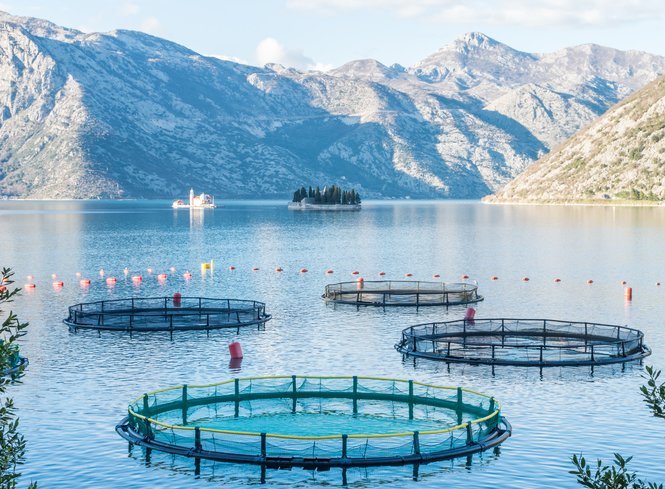
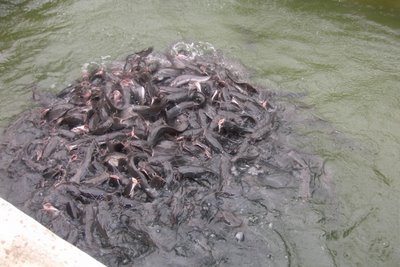
Comments
in finding your email subscription hyperlink or e-newsletter service.
Do you've any? Please permit me realize in order that I may
just subscribe. Thanks.
Also visit my webpage Credit
Repair Companies Baytown TX: https://baytown.creditrepair.repl.co/